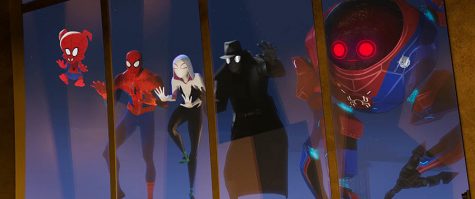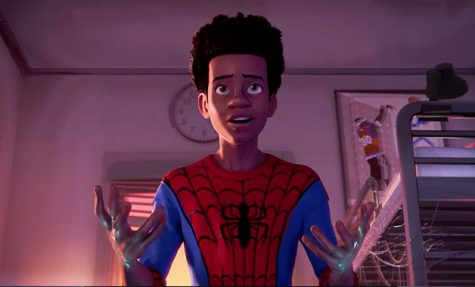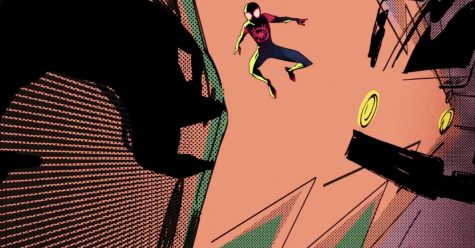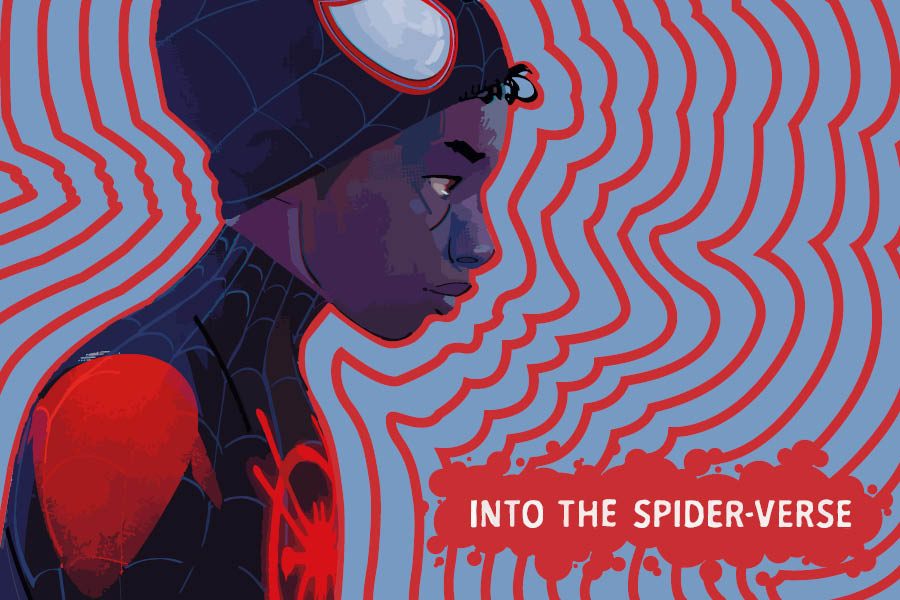“Spider-Man: Into the Spider-Verse” is an exuberant animated masterpiece
Sony Pictures Animation’s “Spider-Man: Into the Spider-Verse” is a prime example of a comic book film done right. With plenty of heart and ripe animation, it is peak superhero cinema. Read one WSS reporter’s thoughts on the film.
Miles, having taken up the mantle of Spider-Man, finds determination within himself.
Back in the 1960s, in a time when the world was plagued with unease and struggle, comic book visionary Stan Lee created the first of what would become many iterations of the Spider-Man, a web-slinging superhero based in New York. His goal in creating the character was to spread an underlying principle that it can be anyone wearing the mask, that any one person could be the hero in their own ways despite their vulnerabilities.
Half a century later, we’ve seen Spider-Man on the big screen in three different movie series over the years, all in the Peter Parker mold of the hero. No matter how many different actors have been placed to play the role, it is always the same webslinger we see fighting bad guys and going about his routines. This has moderately fractured the idea that it could be anyone in his place because all we have seen is the same version of the character played out over and over again.
“Spider-Man: Into the Spider-Verse” breaks this repetition. In “Spider-Verse,” we are introduced to six Spider-People from the comics lore: Miles Morales (voiced by Shameik Moore), Peter B. Parker (Jake Johnson), Gwen Stacy / Spider-Woman (Hailee Steinfeld), Peni Parker (Kimiko Glenn), Spider-Man Noir (Nicolas Cage) and Peter Porker / Spider-Ham (John Mulaney.) They are all drawn together after the villainous Kingpin (Liev Schreiber) opens up multiple dimensions with his self-imposed ‘super collider.’ The Spider-People team up to find their way back to their home dimensions.

The lineup of superheroes that “Spider-Verse” assembles to lead the movie have distinguishing factors to each of them which better allows Lee’s theme to be gleaned. Even in the briefest of scrutinizing, it is clear how diverse of a group they are. On one hand, you have the alternate universe Parker, an indolent and uninspired middle-aged man who has had enough of his job. Then you have Stacy, free-willed and bursting with vitality. Or Spider-Ham, who looks and acts like he came straight out of a Looney Tunes episode.
At this point, you understandably may be thinking “Isn’t that too much for one film to handle?” I agree with you – or, at least, I did agree before seeing the movie. After watching, I have to say, the filmmakers did the very best they could with it. How are they able to make it work? They give each of the Spider-People their moments to shine and show themselves off as much as possible but have the primary protagonist and perspective be filled by one character. That character is Miles Morales.
Morales was created eight years ago by Brian Michael Bendis and Sara Pichelli in Marvel’s Ultimate Comics. Like the comics, the movie portrays him as an intelligent Puerto Rican/African American preteen who attends an elite middle school in Brooklyn. In his free time, he mingles with his former criminal uncle Aaron and graffitis under the radar. In one graffiti trip, he is–you guessed it–bitten by a radioactive spider. Enter a hero’s journey archetype: he learns of his powers, makes companions in the otherworldly Spider-People and attempts to harness his web-slinging ability.

Morales’s story is spiced up by a mixture of uniquity, sincerity and a splash of jovial humor from writer/producer duo Phil Lord and Christopher Miller. As for making him unique, the filmmakers shape him with relatable components, like his upbringing, intertwined with distinctive personality traits and internal conflicts. Lord and Miller employ the same methods that Lee and all the other comic book writers used to formulate Spider-Man and many other personas: some parts of him are derivative, but in the end, you can come to understand and root for him as he is. This ties in with the heartfeltness. A couple beats in the story are decidedly harrowing (especially for a family film), and you can actually feel the emotion radiating in these scenes.
In the humor department, there’s not a lot to say. If you’ve ever checked out Lord and Miller’s other hits (“The LEGO Movie,” the “Jump Street” franchise), then you already have a clear idea of what to expect: side-splitting gags (both visual and spoken), snarkily poking fun at other popular movies and naturally zany characters (Cage’s Noir is one example highlight.)

The utmost selling point for “Spider-Verse” is the groundbreaking animation. To describe the animation style, think of a prototypical three-dimensional animated palette, combined with a hand-drawn slate on the surface, all the while having a glitchy graffiti effect on top and a bucket of colors splashed over it. If that isn’t enough, smaller but noticeable elements such as a pop-up yellow box echoing Miles’s thoughts, squiggly red and purple lines popping up whenever spider-sense is triggered and big borders filling the screen in combat scenes (like a comic) make it slicker. All in all, in a market where Disney and Illumination hog the animation field, it is a breath of fresh air to see a film do something distinctive like this. It should also be known that “Spider-Verse” looks exactly like a comic book as if the filmmakers ripped a page from the Marvel originals and slapped it straight onto the big screen.
The voice cast is all top-tier in their parts. The acting in “Spider-Verse” proves that performances can be sharp even if the actors don’t make physical appearances in the production. Two predominant strong points are Brian Tyree Henry wheeling in a pure, weighty performance as Miles’s caring father Jefferson and Mahershala Ali doing staggeringly unrecognizable voice work as Miles’s Uncle Aaron, showing the extent of his unmatched acting chops.
“Spider-Man: Into the Spider-Verse” is a feature not to be missed. It hones in on personal aspects of the hero and spreads a strong core message about heroism, which has since inspired the Spidersona movement on social media. All the while, it is anchored by innovative animation that alone makes the film worth the watch. “Spider-Verse” promises a wide universe of future projects to be released and, unlike many of the aspiring cinematic universes today, it looks like it may be the one fans have wanted all along. Grade: A+
Your donation will support the student journalists of West High School. Your contribution will allow us to purchase Scholarship Yearbooks, newsroom equipment and cover our annual website hosting costs.

Edward Keen is a senior and this is his second year on staff, where he is Arts Editor. In his free time, he enjoys reading.

Rain Richards is a senior at West and this is his first year on staff. He is a designer for both Online and Print. In his spare time, he plays retro and...




